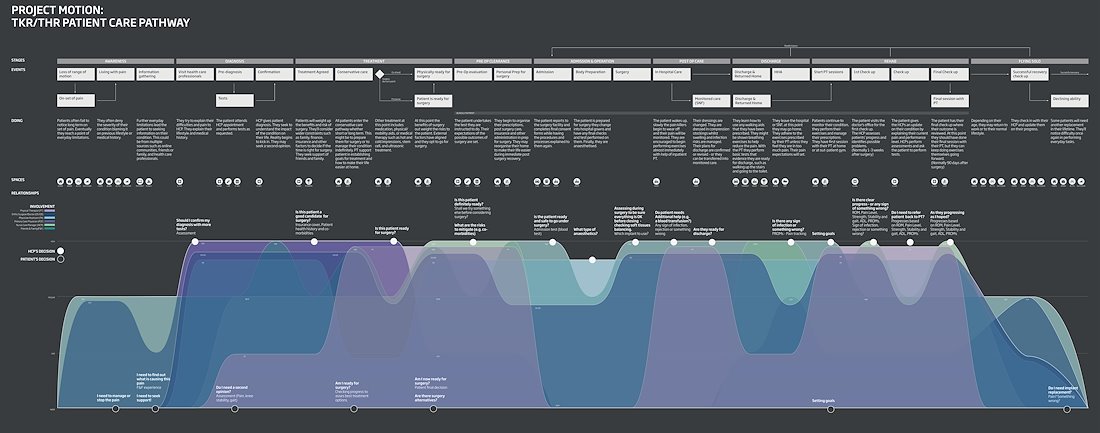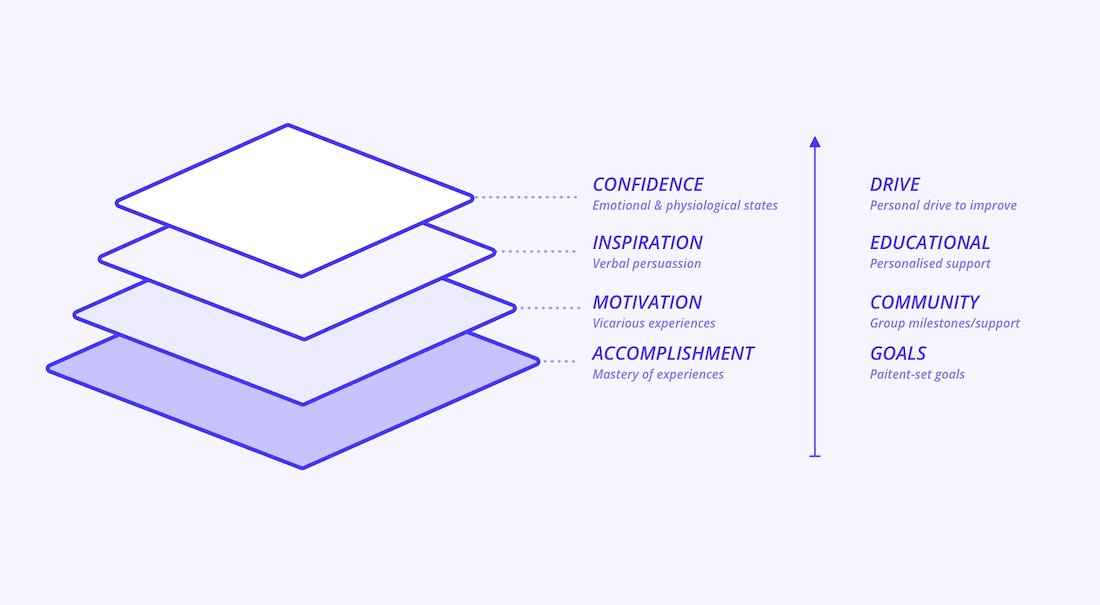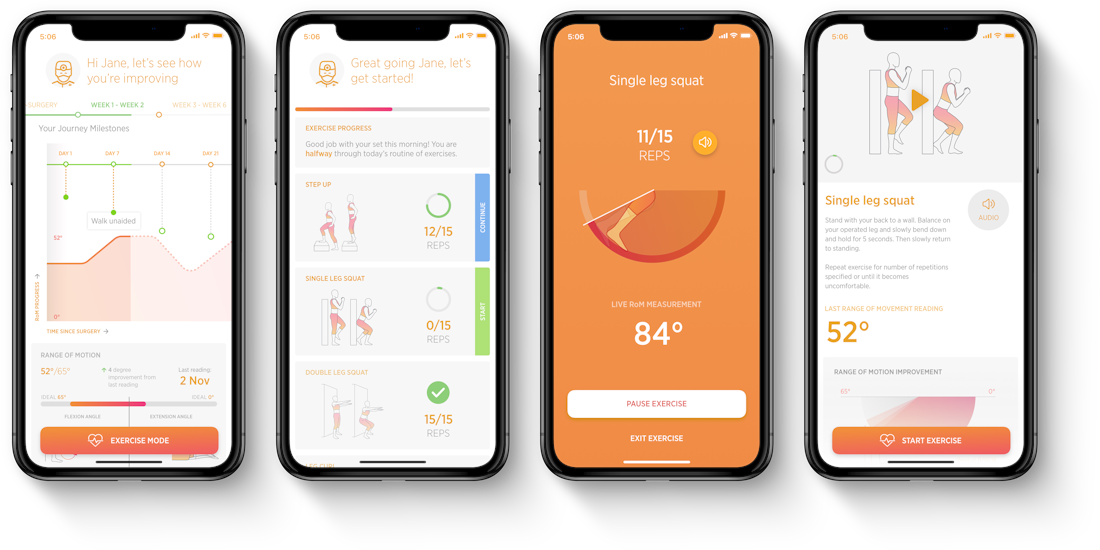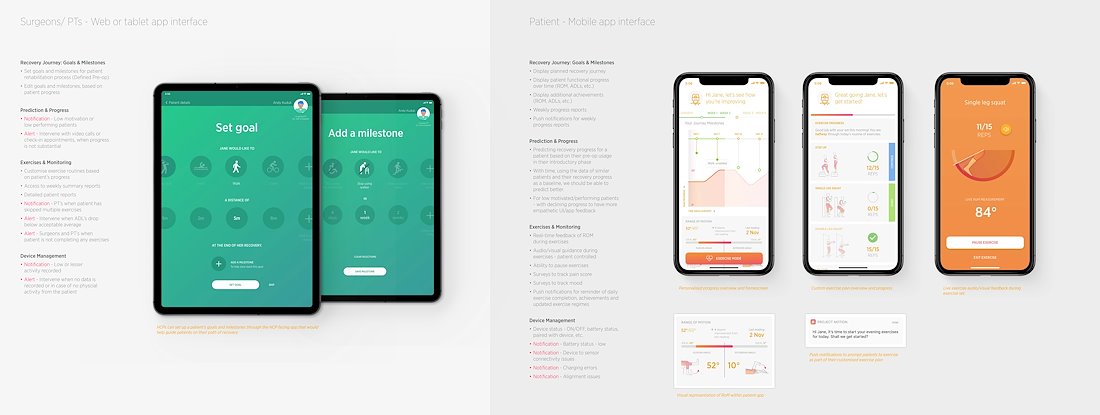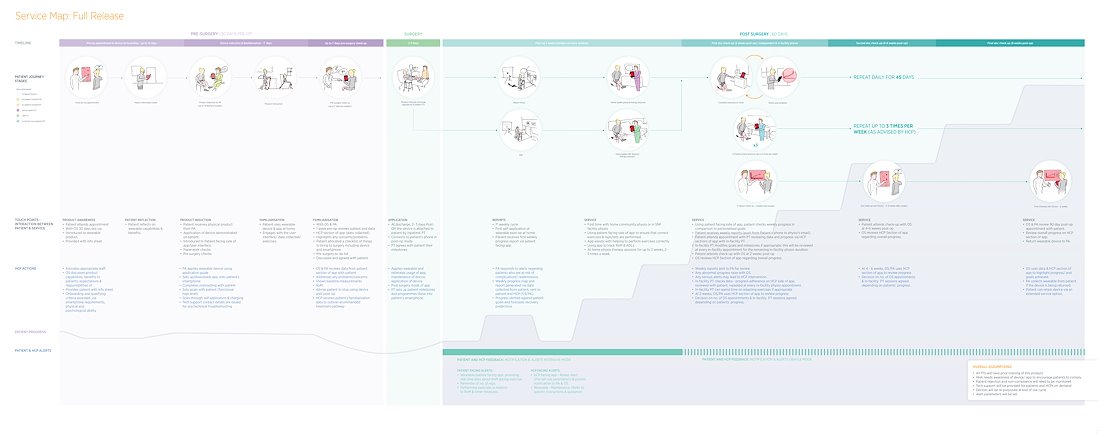PLATFORM
Mobile/Tablet iOS
ROLE
UX Flows
Interaction Design
Interface Design
Project Motion is a conceptual initial project phase for a popular joint replacement implant supplier in the American orthopaedic sector. The company wanted to expand into the wearable healthcare market and focus on quantified prediction to improve patient motivation and engagement.
A cross-functional team of technical engineers, data scientists, healthcare professionals, commercial healthcare experts, ethnographic researchers and service, industrial and user experience designers worked together to conceptualise the product and service offering.

Project Motion – Patient App
GOAL
To provide visual progress identification & quantified prediction concepts to improve patient motivation and engagement in the context of a total knee replacement recovery (TKR) regime.
PURPOSE
The cost of demotivated and unsupported patients through a process of recovery cost more to healthcare services across the world than some of the treatments themselves. With the new insurance bundle system rolling out across the United States, healthcare providers were now being rewarded for better outcomes from patients.
Rather than just rely on the system in providing the best care up to treatment, patients driven by self-motivation and adequate support post treatment, would help ease some of the day-to-day pressures on physiotherapists and trainers enabling a more efficient healthcare service.
RESEARCH INSIGHTS
Using a variety of research methods likes in-home interviews with patients, interviews and workshops with healthcare professionals (surgeons, physical therapists, etc.), an overview of key recurring themes and pain points were highlighted. This helped synthesise a series of insights that guided the conceptualisation and service map.
Some key highlights:
1 .Patients felt engagement with the healthcare professionals were very disjointed and felt like they needed more assurance especially immediately post surgery
2 .Physical therapists sessions were often quite hard logistically if patients needed to get to a clinic to get reviewed. In some cases the visiting therapist was different to the previous session, which meant patients spent more time explaining the history rather than getting support for immediate concerns.
3 . Healthcare professionals highlighted the need to recognise early risk factors, which often dictated the outcome of the patient. This meant early identification/action could drastically improve recovery.
4 . Education of TKR and the various processes was important. In high stress situations, patients often struggled to completely understand the details of the procedure and often the pressure of assurance and education came down to the recovery healthcare professionals over short review sessions.
CONCEPTUALISATION
The design brief included the design of a wearable device that sat within a service system supporting the process of recovery. This included the industrial design of the wearable in parallel to the technical build of the device. With the team supporting on these aspects, the digital strategy of the supporting application was brainstormed and conceptualised.
As part of the process strategy, the team were aiming to test 2/3 concepts with patients/healthcare professionals in an on-site study organised in the US.



Initial wireframes to identify key requirement screens
USER TESTING
With a lot of these features not existing as part of a service that is end-to-end, it was an important learning process to see how the various requirements and features realistically worked in the overall system for end users.






INSIGHTS & ITERATION
From the research study, our learnings were multiplied with the addition of prototypes and live demonstration. This helped construct a more informed requirements list for the product and very importantly gave us a clearer direction for the next round of iterations.
Key quotes from the study:
Surgeon 1 “… they [patients] might want to know where they started, and they might want to know what you’re giving them versus where I was yesterday”
Patient 5 “…On the whole, I’m more of a big picture girl (refers to UI illustrations)”
Physical therapist 2 “Keeping them on task to do a specific number is important to them”
Patient 6 “…seeing all of this (information) together is too much.”

Interface design recommendations
FINAL CONCEPT DIRECTION
With the gathered insights and requirements, a concept proposition was shared with the clients with all the learnings gathered over the duration of the project. The final showcase included the tangible product design of the wearable with its functional parts, service map recommendation, patient side and professional side app direction and requirement recommendations, commercial map model and finally product roadmap for phase 2.
KEY LEARNINGS
BETWEEN DISCIPLINES
Understanding engineering requirement in the building of accurate metric measurements were a hard learning curve. Time is always a tricky factor in such situations, and maybe integrating our work paths at an earlier stage would have improved on our efficiency. Going that extra mile in translating between disciplines is a skill I truly hope to learn and exercise more of.
CROSS-TEAM LEARNING
Some key learnings came from a parallel project that was being done in a similar space by a totally different team. This meant sharing our learnings across the board helped giving the teams a holistic perspective on critical issues. Taking time to connect the dots and deriving knowledge from each of our experiences was eye-opening.
EMPATHY
Working with patients increased my understanding of how I approached research as a subject. Applying that emotional context to the recovery journey with very little personal experience was uncomfortable yet enlightening.
